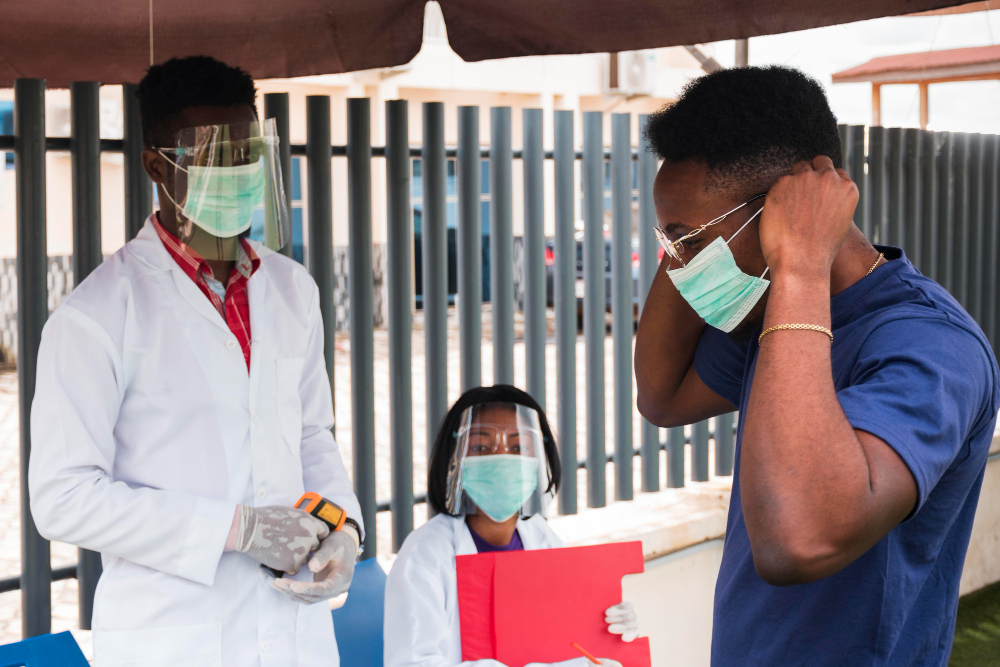The tale Covid infection (Coronavirus) cases keep on flooding through Africa in the midst of what has been marked as the ‘third wave’. Like a few African nations, Kenya has been seeing an uptick in the quantity of cases since February — subsequent to encountering a great decrease in the quantity of cases from October-January.
The most recent wave has seen the energy rate climb strongly, picking to 17 percent on Walk 16, 2021, when 1,064 contaminations were accounted for from an example size of 6,151. The most elevated rate the nation has at any point seen is 18% in October.
Kenya is among the African nations where the 501Y.V2 variation — first detailed in South Africa — was distinguished. On Walk 3, the nation got its underlying transfer of the AstraZeneca immunization containing 1.2 million dosages obtained through UNICEF from COVAX office.
On the need rundown would be more than 400,000 wellbeing laborers, trailed by educators, security officials and afterward those with hidden conditions.
As the landmass fights one more Coronavirus wave — compromising its benefits of months — the public authority has presented a huge number of measures. The most recent round has seen the public authority fix control measures since Walk 12, with President Uhuru Kenyatta expanding the 9 pm-4am time limit for an additional two months.
He likewise prohibited political assemblies for 30 days and set a limit for individuals going to strict or burial service occasions.
How it began
Kenya detailed its first Coronavirus case in Walk 2020, inciting travel limitations in and outside of capital Nairobi, just as a 7pm-4am check in time and conclusion, everything being equal, and learning foundations.
All get-togethers, including strict, political or social gatherings, were reduced in a bid to implement separating. The actions were set up until June, when they were halfway loose, permitting development into and out of Nairobi.
Be that as it may, the inspiration rate stayed high, averaging at around 13% in May and June. This was before the president lifted the bar all through Nairobi and three different areas planned as areas of interest.
The facilitating was additionally joined by unwinding on conclusion of love places, including houses of worship and mosques, which permitted a little quantities of admirers under 58 years old to assemble at a time.
Regardless of the let-up in the control rules on social events and development, contaminations proceeded to fall and the energy rate plunged.
The empowering pattern proceeded consistently, provoking the president to survey control estimates further on September 28.
Other than decreasing the time limitation hours to 11pm-4am (from prior length of 9pm to 4am), the president had uplifting news for revelers and the accommodation business injured by long periods of conclusion of amusement joints.
“The preclusion against the activity of bars and the denial against the offer of cocktails and drinks by standard cafés and diners will stand cleared with impact from September 29,” Kenyatta had declared.
While the returning of drinking sanctums was to be done in recognition of time limit rules and general rules on removing and cleanliness conventions, these were removed from the window: The quantity of contaminations flooded scarcely three weeks after the fact.
Kenya hit inspiration pace of 16% in October and a high of 20% in November (from 4% in September), as caught by the worldwide metric Crown Tracker.
The nation had recorded a low of 53 new contaminations on September 28, which flooded to 1,494 new cases toward the finish of October. In excess of 15,000 new contaminations and 300 passings were recorded in October.
“In September, our Coronavirus bed inhabitance went down 60%. We had leveled the bend to under 5% energy rate suggested by the World Wellbeing Association,” said the president in his location to the country on November 4.
“In any case, after 38 days, we have encountered an inversion. On the off chance that Coronavirus bed inhabitance had gone somewhere around 60%, giving us solace to re-open in September, the inhabitance went up 140% during the 38 days of facilitated measures,” he added.
While the flood in contaminations were deciphered in certain quarters to mean a subsequent wave, WHO dismissed cases that the new diseases, which additionally influenced South Africa and Ethiopia, added up to a subsequent wave.
The diseases that followed were not tantamount to the second dangerous wave that was clearing across Europe at that point, as indicated by Ngoy Nsenga, WHO-Africa Coronavirus occurrence supervisor.
“The basics encompassing the infection in Africa continue as before as prior to refuting the probability of a new wave. The elements are additionally extraordinary when Africa is contrasted with Europe,” Ngoy added.
The infection, as per the authority, had stayed unaltered, there having been no changes at that point, he advised Sensible in a meeting.
He believed that the adjustment in numbers had been educated by facilitating of mediations in September, prompting individuals dumping dismissing control insurances.
The additions
Following the panic, Kenya moved to fix a few limitations it had loose in September, decreasing working hours for bars and diners and adding an additional hour to check in time length. A fine of up to $200 was additionally forced for the individuals who didn’t wear a cover in broad daylight places.
The public authority likewise reported that all schools would open in January, an advancement that caused specialists to implement gauges significantly more carefully.
Limitations were all the more powerfully upheld by the police utilizing the General Wellbeing Act and the Public Request Act effectively set up preceding the pandemic. Thus, contaminations started to moderate, dropping from a high of 18% early November to around 10% toward the start of December.
The figures dropped 6-8 percent through December, prior to settling at under 5% in January as schools returned. By February, inspiration rate in for the most part settled at under three percent, as per wellbeing clergyman Mutahi Kagwe.
Kenya’s overall achievement has, in any case, not been without hitches and difficulties. The testing limit has stayed low and as of February 27, aggregate tests remained at 1,295,556 of every a populace of 48 million individuals.
Specialists have attempted to secure testing gear and reagents, in the midst of severe grievances of a deficiency of individual defensive hardware (PPEs) among wellbeing faculty in the general medical services area.
Wellbeing clergyman Kagwe in January declared that the public authority will obtain 24 million portions of the Oxford-AstraZeneca antibody, yet it isn’t yet clear how far the plans have gone concerning importation. The date for beginning of immunizations has not been unveiled too.



